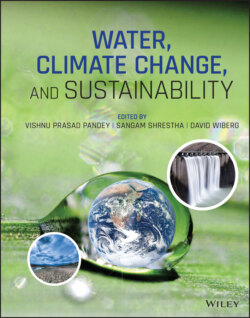Читать книгу Water, Climate Change, and Sustainability - Группа авторов - Страница 31
REFERENCES
Оглавление1 ADB. (2016). Asian Water Development Outlook 2016. Asian Development Bank (ADB), Manila
2 ADB. (2017). Key Indicators for Asia and the Pacific 2016. Asian Development Bank (ADB), Manila, the Phillipines.
3 APWF. 2017. “Yangon Declaration: The Pathway Forward.” Yangon, Myanmar. http://apwf.org/apwf_wp/wp‐content/uploads/2017/12/Yangon‐Declaration.pdf.
4 Bertule, M., Glennie, P., Bjørnsen, P.K. et al. (2018). “Monitoring Water Resources Governance Progress Globally: Experiences from Monitoring SDG Indicator 6.5.1 on Integrated Water Resources Management Implementation.” Water 10 (12): 1744. https://doi.org/10.3390/w10121744.
5 Biswas, A. K. (2008). “Integrated Water Resources Management: Is It Working?” International Journal of Water Resources Development 24 (1): 5–22. doi:http://dx.doi.org/10.1080/02508060408691775.Cap‐Net. 2009. IWRM as a Tool for Adaptation to Climate Change. Training Manual and Facilitator’s Guide, Cap‐Net/UNESCO‐IHE.
6 Elder, M. and King, P. eds. (2018). Realising the Transformative Potential of the SDGs. Institute for Global Environmental Strategies (IGES).
7 Fader, M., Cranmer, C., Lawford, R., and Engel‐Cox. J. (2018). “Toward an Understanding of Synergies and Trade‐Offs Between Water, Energy, and Food SDG Targets.” Frontiers in Environmental Science 6 (November). https://doi.org/10.3389/fenvs.2018.00112.
8 Giordano, M. and Shah. T. (2014). “From IWRM Back to Integrated Water Resources Management.” International Journal of Water Resources Development 30 (3): 364–76. https://doi.org/10.1080/07900627.2013.851521.
9 GoLaoPDR. (2018). Lao People’s Democratic Republic: Voluntary National Review on the Implementation of the 2030 Agenda for Sustainable Development. Government of the Lao People’s Democratic Republic (GoLaoPDR), https://sustainabledevelopment.un.org/content/documents/19385Lao_Final_VNR_19_June_2018_web.pdf
10 Grigg, N.S. (2008). “Integrated water resources management: balancing views and improving practice.” Water International 33 (3): 279–292.
11 Hoff, H. (2011). “Understanding the Nexus: Background paper for the Bonn 2011 Nexus Conference.” The Water, Energy and Food Security Nexus, 16 – 18 November 2011. Bonn: Stockholm Environment Institute (SEI).
12 Hooper, B. (2010). “River Basin Organization Performance Indicators: Application to the Delaware River Basin Commission.” Water Policy 12 (4): 461–78. https://doi.org/10.2166/wp.2010.111.
13 ICSU. (2017). A Guide to SDG Interactions: from Science to Implementation. Edited by D.J. Griggs, M. Nilsson and A. Stevance. Paris: International Council for Science (ICSU). doi:10.24948/2017.01.
14 IPCC. (2014). “Part A: Global and Sectoral Aspects.” In Climate Change 2014: Impacts, Adaptation, and Vulnerability., edited by V.R. Barros, C.B. Field, D.J. Dokken, M.D. Mastrandrea, K.J. Mach, T.E. Bilir, M. Chatterjee, et al., 1132. Cambridge, United Kingdom and New York, NY, USA: Contribution of Working Group II to the Fifth Assessment Report of the Intergovernmental Panel on Climate Change (WGIIAR5:IPCC), Cambridge University Press.
15 Isnugroho, and Nielsen, T.K. (2014). Functional Frameworks for River Basin Governance. Jawa Tengah Indonesia: Research Center for Water Resources‐Indonesia, Center for River Basin Organizations and Management (CRBOM), and Network of Asian River Basin Organization (NARBO).
16 KOC. (2019). Cambodia's Voluntary National Review 2019 of the Implementation of 2030 Agenda. Kingdom of Cambodia (KOC), https://sustainabledevelopment.un.org/content/documents/23603Cambodia_VNR_SDPM_Approved.pdf
17 MRC. (2011). 1995 Mekong Agreement and Procedures. The Mekong River Comission (MRC), Vientiane, Lao PDR.
18 MRC. (2016a). IWRM‐based Basin Development Strategy 2016–2020 for the Lower Mekong Basin. The Mekong River Comission (MRC), Vientiane, Lao PDR
19 MRC. (2016b). Strategic Plan 2016–2020. The Mekong River Comission (MRC), Vientiane, Lao PDR
20 MRC. (2019). Mekong River Basin Indicator Framework. The Mekong River Comission (MRC), Vientiane, Lao PDR
21 Mysiak, J., Henrikson, H.J.,Sullivan, C. et al. (Eds.). (2010). The adaptive water resource management handbook. London, UK: Earthscan.
22 NARBO. (2009). “IWRM Guidelines at River Basin Level – Part 1: Principles.” http://www.narbo.jp/index.htm.
23 RTG. (2017). Thailand’s Voluntary National Review on the Implementation of the 2030 Agenda for Sustainable Development. Royal Thai Government (RTG), https://sustainabledevelopment.un.org/content/documents/16147Thailand.pdf
24 SD. (2017, 15 June). SDG Indicators Global Database. Retrieved from UN Statistics Division: https://unstats.un.org/sdgs/indicators/database
25 Schuster‐Wallace, C. J. and Sandford, R. (2015). Water in the World We Want: Catalysing National Water‐Related Sustainable Development. Ontario, Canada: United Nations University Institute for Water, Environment and Health and and United Nations Office for Sustainable Development.
26 Shivakoti, B.R. and Bengtsson, M. (2015). Placing water at the core of the Sustainable Development Goals (SDGs): why an integrated perspective is needed. IGES Policy Brief No.31, Hayama, Japan: Institute for Global Environmental Strategies (IGES).
27 Smith, M. and Clausen, T.J. (2018). Revitalising IWRM for the 2030 Agenda.: World Water Council Challenge Paper for the High‐Level Panel on IWRM at the Eighth World Water Forum, Brasilia: World Water Council.
28 SRV. (2018). Viet Nam’s Voluntary National Review on the Implementation of the Sustainable Development Goals. Socialist Republic of Vietnam (SRV), https://sustainabledevelopment.un.org/content/documents/19967VNR_of_Viet_Nam.pdUNDESA. 2019. “Handbook for the Preparation of Voluntary National Reviews by High‐Level Political Forum (HLPF) on Sustainable Development.”
29 UN Environment. (2018). “Progress on Integrated Water Resources Management. Global Baseline for SDG 6 Indicator 6.5.1: Degree of IWRM Implementation.”
30 UNEP. (2011). Decoupling natural resource use and environmental impacts from economic growth. A Report of the Working Group on Decoupling to the International Resource Panel, United Nations Environment Programme (UNEP).
31 UNU/UNOSD. (2013). Water for Sustainability: Framing Water within the Post‐2015 Development Agenda. Hamilton: United Nations University Institute for Water, Environment and Health (UNU), UN Office of Sustainable Development (UNOSD), Stockholm Environment Institute (SEI).
32 UN‐Water. (2016a). Water and Sanitation Interlinkages across the 2030 Agenda for Sustainable Development. Geneva.
33 UN‐Water. (2016). Integrated Monitorign Guide for SDG 6 Targets and global Indicators. UN‐Water.
34 UN‐Water. (2019). Water Facts. Accessed September 2019. https://www.unwater.org/water‐facts/.
35 WEF. (2011). Water Security: The Water‐Food‐Energy‐Climate Nexus World Economic Forum Water Initiative. Washington: The World Economic Forum (WEF), Island Press.
36 WEPA. (2015). WEPA Outlook on Water Environment Management in Asia 2015. Ministry of the Environment Japan (MOEJ) and Institute for Global Environmental Strategies (IGES), Hayama, Japan.
37 Weststrate, J., Dijkstra, G., Eshuis, J. et al. (2019). “The Sustainable Development Goal on Water and Sanitation: Learning from the Millennium Development Goals.” Social Indicators Research 143 (2): 795–810. doi:https://doi.org/10.1007/s11205‐018‐1965‐5
